Company
R+D and Quality
We firmly believe that staying one step ahead is the best way to lead the future. We invest strongly in researching, innovating and improving our processes to keep our competitive edge and ensure the company’s future.
The main projects currently under way aim to:
- Improve drying processes
- Improve steam production processes
- Increase the value of by-products
- Develop new industrial packaging
- Introduce new technologies into almond-sorting processes
Here are some of Borges Agricultural & Industrial Nuts projects carried out:
BORGES AGRICULTURAL & INDUSTRIAL NUTS, S. A. it has received the granting of an aid of 86,102.06 euros for its energy savings and efficiency project “Energy consumption reduction at Borges 2”, managed by the INSTITUTE OF DIVERSIFICATION AND ENERGY SAVING (IDAE), aid co-financed by the European Union through the ERDF Operational Programme for Sustainable Growth 2014-2020. The project consists of two different actions. The first is to replace one almond dryer without air recirculation with another with much more efficient recirculation. The second has consisted of replacing a fixed speed air compressor with a variable speed and high energy efficiencycompressor, as well as the addition of an air dryer and an advanced control system that provide a plus of efficiency. An estimated energy saving of 74.05 tep/year has been achieved.
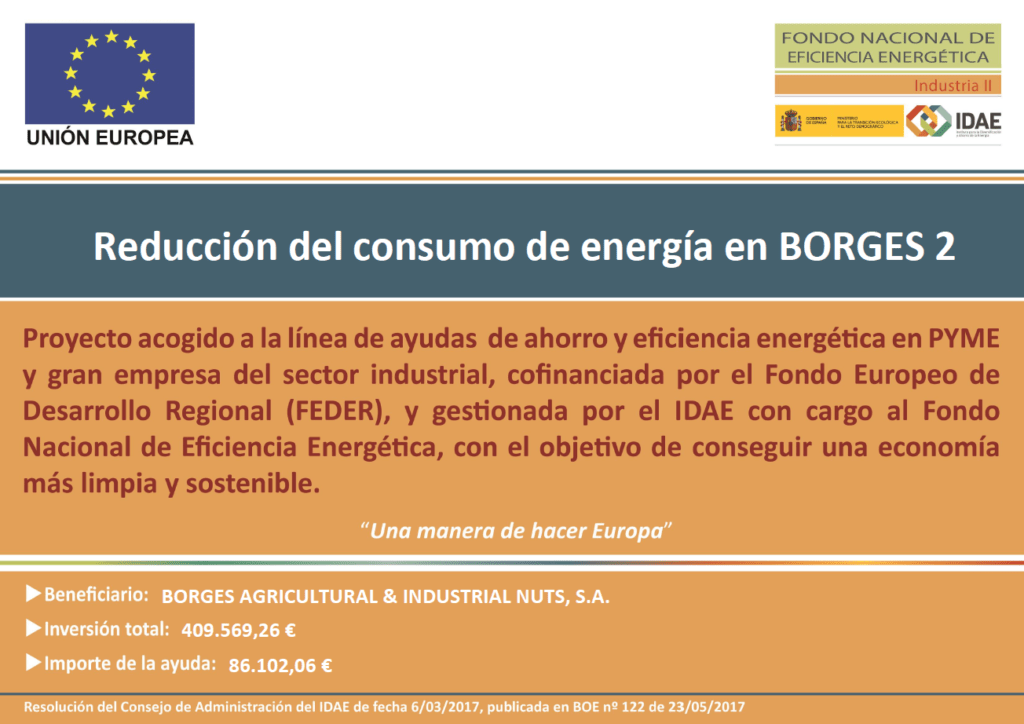
Main objective: Sector project for the development of systems that can be used on an agronomic, productive and industrial scale to detect and eliminate bitter almonds.
Specific objective 1: Agronomic evaluation in the field of bitter trees and their geolocation for possible elimination. Confirmation by Near Infrared Spectroscopy (NIRS) technology and use of novel cyanide kits.
Specific objective 2: Development of discriminant models with NIRS laboratory instruments, which allow the bitter almond to be separated from the sweet in batches at the entrance of the Almendreras cooperative.
Specific objective 3: Validation of prototypes with NIRS technology that allow the detection and elimination of bitter almonds, individually grain by grain (one by one), of the sweet almond items in the production line.
This project to eradicate bitter almonds has an execution budget of 573,999 euros and is part of the support to Operational Groups of the European Innovation Association (AEI), whose objective is to increase agricultural productivity and sustainability, through the National Program of Rural Development (PNDR) 2014-2020, in its 2018 call.
The works are funded at 80% by the European Agricultural Fund for Rural Development (EAFRD) and 20% by the Ministry of Agriculture, Fisheries and Food, through Royal Decree 169/2018, of March 23.
The agency responsible for the content of this project is the Operational Group: Detection and Eradication of Bitter Almonds, the Directorate General for Rural Development, Innovation and Forest Policy being the authority in charge of managing the application of the EAFRD and corresponding national assistance.
They can also expand the information in the following link: http://ec.europa.eu/agriculture/index_en
Actions: Thus the most important actions that are intended to be carried out in each of the points are the following:
At the field level. Geolocation of most of the candidate trees with the presence of bitter almond from commercial farms. Once these trees have been marked that will be identified as having an agronomic behavior different from the rest, different rapid analysis tests will be carried out, with cyanhydric detection kits, with portable NIR technology (set to points during the first year) to check and confirm the presence of bitter almonds in these trees.
At the entry level in the reception centers. Here you will work mainly at two levels. The first is the use of laboratory analytical technology for the detection of hydrocyanic acid from the degradation of amygdalin present in bitter almonds through innovative detection kits. And the second will be batch discrimination, through NIR technology at the reception of the almond that the farmer takes to his cooperative. Again, a discriminant model will be developed to separate both groups of almonds (sweet vs. bitter).
At the processing line level. Calibration and validation of an on-line Hyperspectral NIR prototype to eliminate bitter almonds one by one with the presence of tonsillin.
Therefore, we hope to reach several temporary milestones that serve to eliminate the bitter almond from our fields, such as the GPS geolocation of trees, the protocols for action with the analytics of hydrocyanic kits, NIR discrimination models in the field (leaf and fruit) and in reception at the central or cooperative; and finally validate the NIR Hyperspectral prototypes that allow the identification and elimination of bitter almonds in the online processing line, one by one, validating at all times each of the actions.
Expected results: The potential impacts and focus area that this GO “Detection and Eradication of Bitter Almond”, led by ALMENDRAVE, aims to respond to the general objectives of the AEI-Agri, as well as work and influence the Focus Area 2A and 3A.
Therefore, the ultimate impact on the sector is to increase the added value of the national almond tree sector (from the producer to the consumer), and that it offers a product of the highest possible quality and distribution chain, and that therefore gives the possibility of competing to the Spanish almond, with the almond produced in other parts of the world.
Thus, the formation and implementation of this GO will have an impact on each and every one of the stages from the farmer to the final consumer, through the cooperatives, shelling, processing industries (almond peeling and repelling), industries that use almonds as a raw material in the elaboration of its products (such as turroneras, chocolate industries, snack industry in retail) and the distribution industries of these products, that is markets, supermarkets and large stores
The possibility of addressing the problem from three levels of action, will allow to show the effectiveness of each of the filters of action in which it will work.
Economic sustainability:
The GO is designed from its inception to meet Focal Area 2A and 3A, improving the economic results of farms and improving the competitiveness of potential users of this innovation. In addition, if we are eliminating bitter almond from our fields, we are increasing the quality of the entire agri-food chain, that is from the farmer, to the final consumer, through groups, producer organizations, cooperatives, industry and interprofessional organizations.
Environmental sustainability:
The environmental sustainability is reflected in the fact that in the three levels in which the GO will work, that is, field, entrance to cooperative and production line, it will work in a sustainable way and without polluting the environment. Thus, the proposed technology to address the objectives and challenges at no time uses hazardous chemical agents, nor will it generate toxic waste.
In addition, many of the members of the GO have Environmental Management Systems (ISO-14001), implementing a comprehensive environmental protection plan.
Social sustainability:
The GO, being a multidisciplinary association of many actors throughout the value chain, will allow to shorten the distance between the scientific and research offer, which provides a reference such as IRTA, with the real needs of the primary agricultural and agri-food sector, represented both by Producer Organizations, Agrifood Cooperatives and private companies.
In addition, this GO aims to digitize and Big Data, (with the use of cutting-edge technologies, such as near-infrared spectroscopy (NIRS), crucial today to fix the population in rural areas, thus favoring the development of same.

Main objective: To obtain a new solution to classificate and separate bitter and sweet almonds.
The project has received the financial support of the CDTI, through a grant co-financed by the European Regional Development Fund (ERDF) within the “Programa Operativo de Crecimiento Inteligente 2014-2020 (CRIN)”, which aims to enhance the research, technological development and innovation. In this case, new and appropriate technologies have been studied and defined to carry out the development of a new prototype capable of detecting bitter almonds (derived from the presence of the amygdalin glycoside) in an industrial environment and taking into account the production of 1000kg / h.
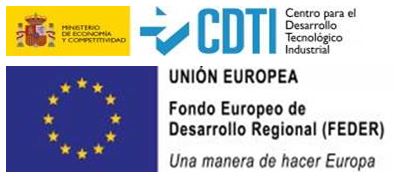
Main objective: Improvement of the energy efficiency of the technology in equipment and processes, related to air conditioning and industrial cold.
Investment: € 246,228
Location: Production center located at C / Flix nº29 Reus
Grant: €52,514.99 worth of grants given for research towards energy efficiency in SMEs and large companies in the Industrial sector, co-financed by the European Regional Development Fund (ERDF) and managed by IDAE from the national energy efficiency fund.

Main objective: Project for the expansion and modernization of the processing nuts facilities
Investment made: € 362,118.27
Location: Production center located in Crta. Olivenza, Badajoz
Help obtained: € 86,908.38 through the provisions of Decreto 306/2015, de 4 de diciembre, por el que se establece el Régimen de Incentivos Agroindustriales en el Ámbito de la Comunidad Autónoma de Extremadura, relating to development grant through the European Agricultural Fund for Rural Development (EAFRD)
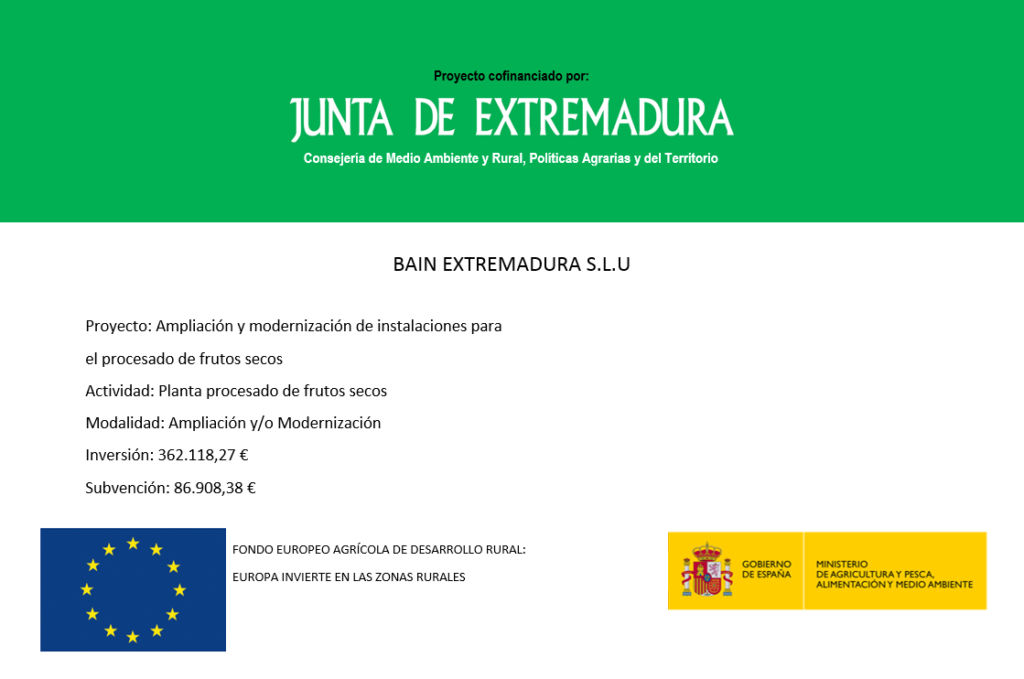
BORGES AGRICULTURAL AND INDUSTRIAL NUTS, SA has carried out the “Project for the design and development of a new innovative almond paste production line at the Borges 2 facilities” in the municipality of Reus, file number 93800042017. This project has been carried out thanks to the grant set out in Priorities 3.A) and 5), of Measure 04 corresponding to “Investments in physical assets”, and in Operations 04.02.01 and 04.02.02 of the “Program for rural development in Catalonia for the 2014-2020 period”, for an amount of € 469,890.31, receiving a grant of € 46,989.03 co-financed in the following proportions: 57% by item AG06 D / 77000400/6130/0000 of DARP budgets and 43% from FEADER.


ALMON Operational Group: Keys to improve the management of moniliosis in almond trees
The ALMON Operational Group (GO) is made up of the consortium of companies, CRISOLAR NUTS SL, as project leader, BORGES AGRICULTURAL & INDUSTRIAL NUTS, UNIÓ NUTS, OCEAN ALMOND, FRUITS SECS LES GARRIGUES and IRTA as technology centre.
In Catalonia, the cultivation of the almond tree (Prunus dulcis) is a typical crop of the coastal regions of Tarragona and the Lleida plain, mainly rainfed, which had traditionally been reserved in marginal areas because it is one of the few productive alternatives in semi-arid lands and low quality soils. However, based on the IRTA studies, new varieties and new techniques for growing irrigated almond trees have been promoted (new production models, new irrigation strategies, etc.). In this context of new agronomic practices and almond cultivation systems, it is necessary to pay attention to diseases that may limit the potential development and consolidation of new irrigated plantations, such as the disease caused by Monilinia spp. The objective of this project has been to improve the knowledge of the agents that cause moniliosis in almond trees to generate essential information to improve its control.
Final results and practical recommendations
Studies to identify the sources of primary inoculum have shown that, in the farms evaluated, the soil below the trees does not present spores of Monilinia spp., and that the main source of spores are the mummies present in the soil and in the tree, especially the latter. Wood cankers with symptoms of moniliosis also showed spores of this fungus. Therefore, it is recommended to eliminate all this type of plant material during autumn-winter so that the primary inoculum for the following season is as little as possible.
As a source of secondary inoculum, Monilinia spp. as the causative agent of the points of infection with symptoms of the disease. In addition, its incidence was highly correlated with weather conditions, mainly rain. Spores of Monilinia spp. throughout the phenological cycle of the crop, in flowers and during fruit development, as well as in cankers. In contrast, environmentally, the presence of Monilinia spp. in the evaluated fields it can be considered insignificant, and not decisive as a source of secondary inoculum. The treatments for its control should be applied when the risk of infection occurs.
All the strains isolated in these fields have been identified as Monilinia laxa, and differences have been observed between the isolates regarding their ability to infect flowers and fruits.
When characterizing and monitoring the disease in the field to assess the damage and losses it produces, a high variability has been observed in the field, but an evaluation of trees up to 2 m is sufficient. Once again, it has been detected that the number of affected inflorescences and/or buds is highly affected by weather conditions, with the 2020 campaign being the one with the highest incidence of disease.
Monitoring of the disease in Catalonia, but also in other producing areas, has shown that the main species causing this disease is M. laxa. With the isolates obtained and evaluated, no resistance to the most widely used fungicides in the intensive management of this crop has been detected; Nor have differences been detected in the baseline of fungicides such as fludioxinil, fenbuconazole, pyraclostrobin, tebuconazole and difenoconazole
Conclusions
- The main species that causes moniliosis in almond trees is Monilinia laxa.
- The primary inoculum sources are mummies, mainly those located in trees, and also cankers.
- As the main source of secondary inoculum, it has been found that the spores of M. laxa are mainly present in flowers and fruits during different stages of their development, as well as in cankers. Environmentally, the presence of this pathogen in the field is practically nil.
- Evaluations of the incidence of disease in the field can be carried out by counting the plant material with symptoms that is located up to 2 meters high; evaluation of whole trees is not necessary.
- The presence of Monilinia spp., and mainly M. laxa, has been monitored in all production areas, both in Catalonia and in the rest of the Spanish State.
- Isolates from samples obtained from fields with intensive management, and evaluated in this project, have not shown resistance to any of the 6 fungicides studied: fludioxinil, fenbuconazole, pyraclostrobin, boscalide, tebuconazole and difenoconazole.
Project dates and budget
- Start date: July 2019
- End date: September 2021
- Total budget: €211,364.00
− DARP funding: €86,380.08
− EU funding: €65,163.92
− Own financing: €59,820.00
Funded by:
Project financed through Operation 16.01.01 (Cooperation for Innovation) through the Catalan Rural Development Program 2014-2020.
Borges Agricultural & Industrial Nuts, together with Crisol de Frutos Secos SL., Ocean Almond SL and Fruits Secs de les Garrigues SCCL; and with the participation of IRTA as a technological center; is working on Strategies for the sustainable control of Monilinia spp. in almond trees (MONCONTROL).
The few active materials with fungicidal activity authorized for almond cultivation, together with the high pressure of old and new diseases in new almond plantations, make studies related to one of these fungal diseases such as Monilinia spp. Therefore, the main objective of the project is to design new control strategies against Monilinia Spp. in almond, applied in the field.
MONCONTROL is part of the aid from the Operational Groups of the European Association for Innovation (AEI) in terms of agricultural productivity and sustainability, financed by the Department of Climate Action, Food and Rural Agenda and by the European Agricultural Funds for Rural Development (EAFRD).
Funded by:
Project financed through Operation 01.16.01 (Cooperation for innovation) through the Rural Development Program of Catalonia 2014-2022.
Quality
Borges Agricultural & Industrial Nuts pays great attention to quality throughout the entire production process, from selecting the best sources and products available, to the processing and packaging of nuts. The Group follows the most stringent quality standards to deliver the highest level of food safety and traceability. The company’s quality certificates include the following:
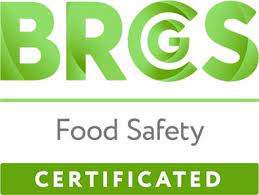
BRC – It is the most widespread international certification to ensure supplier quality and food safety system regarding distributors and supermarkets.
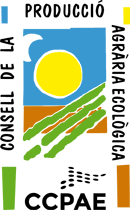
CCPAE – Audit and certify that the food products are grown under ecological criteria approved by the European Union and international bodies.
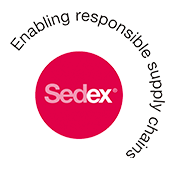
Sedex – It is a common audit methodology and report format compiling best practices in ethical trade audit techniques.

Halal – Quality certificate endorsed by the Islamic community.
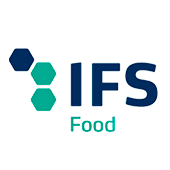
IFS – Guarantees and certifies the integrity of the food chain industries.
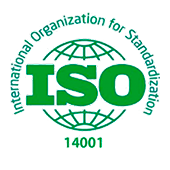
ISO 14001 – Main reference for environmental management in all organizations around the world.

Kosher – Approved by the Orthodox Union for the supervision of standards of health, hygiene and compliance with religious precepts of Judaism.
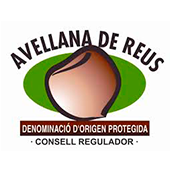
DO Avellana de Reus – It certifies that the production, processing and transformation has been made in the defined area.

Global GAP – It is the quality standard with international recognition for agricultural production. It guarantees a safe and sustainable production in order to benefit producers, retailers and consumers in all over the world.

ESAGUA – Certifies water footprint calculation.


